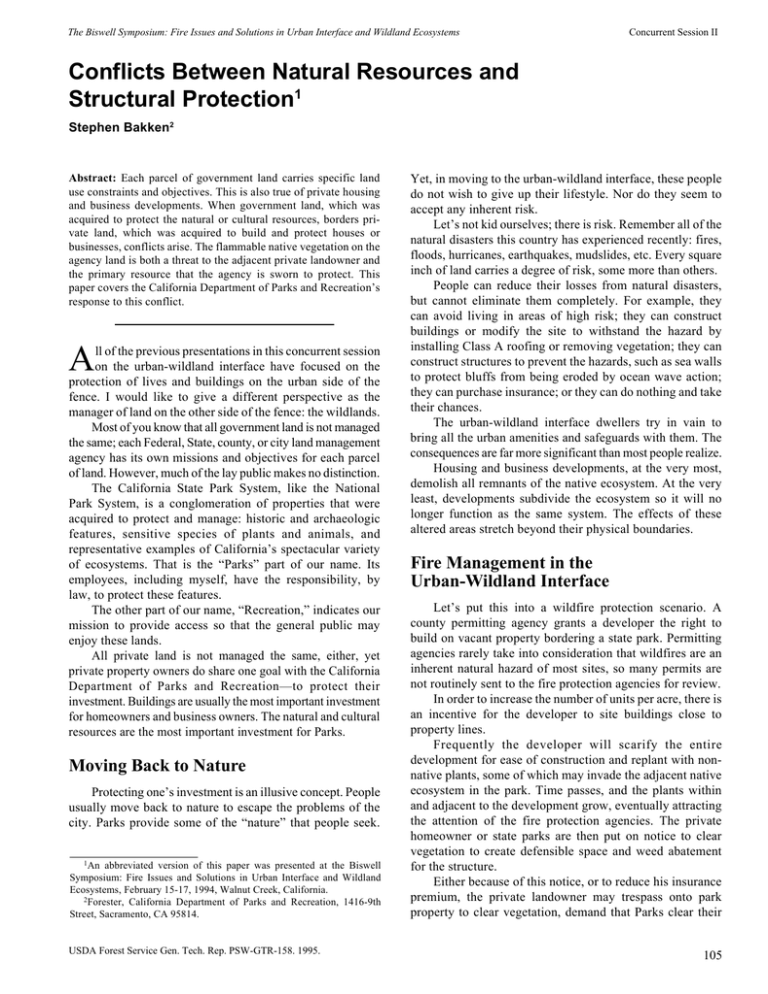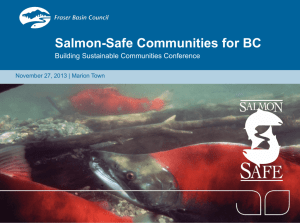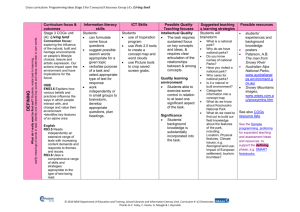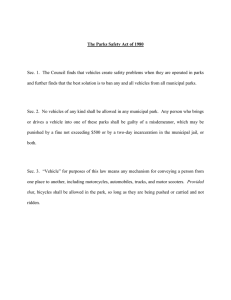Yet, in moving to the urban-wildland interface, these people
advertisement

The Biswell Symposium: Fire Issues and Solutions in Urban Interface and Wildland Ecosystems Concurrent Session II Conflicts Between Natural Resources and Structural Protection1 Stephen Bakken2 Abstract: Each parcel of government land carries specific land use constraints and objectives. This is also true of private housing and business developments. When government land, which was acquired to protect the natural or cultural resources, borders private land, which was acquired to build and protect houses or businesses, conflicts arise. The flammable native vegetation on the agency land is both a threat to the adjacent private landowner and the primary resource that the agency is sworn to protect. This paper covers the California Department of Parks and Recreation’s response to this conflict. A ll of the previous presentations in this concurrent session on the urban-wildland interface have focused on the protection of lives and buildings on the urban side of the fence. I would like to give a different perspective as the manager of land on the other side of the fence: the wildlands. Most of you know that all government land is not managed the same; each Federal, State, county, or city land management agency has its own missions and objectives for each parcel of land. However, much of the lay public makes no distinction. The California State Park System, like the National Park System, is a conglomeration of properties that were acquired to protect and manage: historic and archaeologic features, sensitive species of plants and animals, and representative examples of California’s spectacular variety of ecosystems. That is the “Parks” part of our name. Its employees, including myself, have the responsibility, by law, to protect these features. The other part of our name, “Recreation,” indicates our mission to provide access so that the general public may enjoy these lands. All private land is not managed the same, either, yet private property owners do share one goal with the California Department of Parks and Recreation—to protect their investment. Buildings are usually the most important investment for homeowners and business owners. The natural and cultural resources are the most important investment for Parks. Moving Back to Nature Protecting one’s investment is an illusive concept. People usually move back to nature to escape the problems of the city. Parks provide some of the “nature” that people seek. 1An abbreviated version of this paper was presented at the Biswell Symposium: Fire Issues and Solutions in Urban Interface and Wildland Ecosystems, February 15-17, 1994, Walnut Creek, California. 2Forester, California Department of Parks and Recreation, 1416-9th Street, Sacramento, CA 95814. USDA Forest Service Gen. Tech. Rep. PSW-GTR-158. 1995. Yet, in moving to the urban-wildland interface, these people do not wish to give up their lifestyle. Nor do they seem to accept any inherent risk. Let’s not kid ourselves; there is risk. Remember all of the natural disasters this country has experienced recently: fires, floods, hurricanes, earthquakes, mudslides, etc. Every square inch of land carries a degree of risk, some more than others. People can reduce their losses from natural disasters, but cannot eliminate them completely. For example, they can avoid living in areas of high risk; they can construct buildings or modify the site to withstand the hazard by installing Class A roofing or removing vegetation; they can construct structures to prevent the hazards, such as sea walls to protect bluffs from being eroded by ocean wave action; they can purchase insurance; or they can do nothing and take their chances. The urban-wildland interface dwellers try in vain to bring all the urban amenities and safeguards with them. The consequences are far more significant than most people realize. Housing and business developments, at the very most, demolish all remnants of the native ecosystem. At the very least, developments subdivide the ecosystem so it will no longer function as the same system. The effects of these altered areas stretch beyond their physical boundaries. Fire Management in the Urban-Wildland Interface Let’s put this into a wildfire protection scenario. A county permitting agency grants a developer the right to build on vacant property bordering a state park. Permitting agencies rarely take into consideration that wildfires are an inherent natural hazard of most sites, so many permits are not routinely sent to the fire protection agencies for review. In order to increase the number of units per acre, there is an incentive for the developer to site buildings close to property lines. Frequently the developer will scarify the entire development for ease of construction and replant with nonnative plants, some of which may invade the adjacent native ecosystem in the park. Time passes, and the plants within and adjacent to the development grow, eventually attracting the attention of the fire protection agencies. The private homeowner or state parks are then put on notice to clear vegetation to create defensible space and weed abatement for the structure. Either because of this notice, or to reduce his insurance premium, the private landowner may trespass onto park property to clear vegetation, demand that Parks clear their 105 The Biswell Symposium: Fire Issues and Solutions in Urban Interface and Wildland Ecosystems property, or notify fire protection agency of the dangerous condition perpetrated by Parks. The fire protection agency may cite Parks for noncompliance of the ordinances. In some cases, the fire protection agency may elect to clear the park property and bill the Department for the work. To add insult to injury, the Department is asked to pay for a destructive action on its property that is in direct conflict with its mission to manage natural ecosystems. What is the primary purpose in constructing fire and fuel breaks? According to the newspapers, it is to protect everyone from wildfire. But look at this from Parks’ perspective. Like everyone else, Parks is concerned with protection of human life and will evacuate all park visitors and employees’ families during a wildfire. The Department has even gone so far as to close a park when the fire danger rating reaches extreme. And yes, like everyone else, Parks is concerned with protection of its facilities and performs the required vegetation clearance around structures. Indeed, some of these structures are irreplaceable historic buildings. However, the Department is most concerned with the protection of its principal investment—the natural and cultural features. This is why the land was acquired and why each park unit is unique. Parks usually does not want its native wildlands protected from wildfire; indeed, fire is the most important agent in the management of a dynamic functioning ecosystem in many areas of California. Sometimes Parks might prefer that fire occur in a more planned fashion (i.e., prescribed burning), such as where long-term fire exclusion has produced an extremely high biomass, but we are usually not concerned that the plants and animal species will be irreparably damaged by an unplanned fire. Ironically, some of the techniques used to protect lives and structures from fire can be very damaging to the natural and archaeologic features. Parks is most concerned with bulldozer activity, be it for a firebreak made at the beginning of fire season, or for a fire control line made during a wildfire. Firelines accelerate erosion, destroy archaeological artifacts, allow invasive exotic plants to establish, and degrade the visual esthetics of the park. The vegetation usually recovers quickly on burned areas regardless of whether the fire was planned or not, but may not return to dozed firelines for decades because the organic surface soil and stored seed has been removed. The Department is also concerned with tree felling; it takes a long time to replace an old-growth tree that was dropped to extinguish a smoldering fire high on its trunk. Most of the bulldozer lines on native wildlands are not to protect the park. They are constructed and maintained to protect the surrounding businesses and homes. This is an example of an indirect impact that stretches far outside of the private ownership boundaries. I am not here to point fingers at the fire suppression agencies; they are only doing their job—to protect life and 106 Concurrent Session II property. Indeed, if they do not diligently carry out that duty, they may be sued. A newspaper editorial during the recent southern California wildfires was entitled “Public Lands Shouldn’t Be Allowed to Become Lingering Hazards to Lives and Property.” It would seem that Parks is negligent by perpetuating a hazardous condition. What would be considered best management practices in this simplified example: a 10,000-acre park with one vegetation community, say chaparral? Parks would be remiss in its mission if it attempted to manage all of this community as one homogeneous block. Biological diversity would be better served if Parks were to maintain a mosaic of different age classes of the chaparral. The most ecologically suitable means to accomplish this is to burn scattered plots of the older aged chaparral each year. Yet even this management scheme leaves more than half of the park in a flammable condition. Given hot, dry, windy conditions, a wildfire could spread in any continuous cover of chaparral and threaten adjacent property owners. This is a paradox. Parks can accomplish its mission using the most suitable ecological tool and successfully reduce wildland fuels, yet be held liable for maintaining a “hazardous” condition. The political solution to this hazardous condition is frequently unilateral: “Parks needs to construct fire breaks on its land to protect the private landowner,” or, if you have been following the Mount Diablo State Park controversy, “Parks needs to put non-native cattle on its land to protect the private homeowner.” Do I sound a little defensive? Well, I fail to see why it is Parks’ responsibility to trash some of its most important investments—its natural and archeological resources, in order to protect someone else’s investment. Yes, native vegetation will propagate a fire, but as the Oakland Hills wildfire reminded us, so will exotic plants, shake roofs, and redwood decks. Solutions It is the coordinators’ wish that this conference initiate some concrete change in the way society does business at the urban-wildland interface. From the fire perspective, I would like to see two changes: First, eliminate all of the barriers to prescription burning. Everyone here is probably aware of how difficult it is to conduct a prescription burn in the urban-wildland interface area given air quality constraints, burn logistics, potential liability, and public sentiment. Yet, this is the only tool that comes close to meeting the needs of my agency in managing natural resources while providing a reasonable degree of protection for the adjacent landowner. The greatest barriers that I see are smoke management constraints and the threat of litigation against the landowner and fire protection agency. Second, the scope of liability for wildfire damage against land management and fire suppression agencies must be severely limited. As long as managing a native ecosystem using best management practices is determined by the courts USDA Forest Service Gen. Tech. Rep. PSW-GTR-158. 1995. The Biswell Symposium: Fire Issues and Solutions in Urban Interface and Wildland Ecosystems to be equivalent to “maintaining a hazardous condition,” then there can never be a solution. The current situation is unworkable for my department. When a wildfire occurs, Parks either accepts significant resource damage from suppression activities or risks litigation. The only acceptable tool available to my department, controlled burning, will never be used to its full extent because of the gauntlet of constraints. When Parks is able to conduct a prescription burn, we still face litigation threat. A prescription burn that escapes is worse from a liability standpoint than an arson or accidental wildfire. Even a successful prescription burn can generate lawsuits. For example, if heavy rainfall, following a controlled burn, USDA Forest Service Gen. Tech. Rep. PSW-GTR-158. 1995. Concurrent Session II produces a mudslide that destroys a home, Parks will likely be sued. In conclusion, without significant change in the constraints to prescription burning and especially tort liability, Parks will be unable to accomplish its mission in the urbanwildland interface zone. I should not close without saying that Harold Biswell, or “Doc” as we called him, was instrumental in starting the Department of Parks and Recreation’s Prescribed Burn Program. I believe that he would smile if this conference in his honor was instrumental in changing the way society manages fire in the urban-wildland interface. 107







